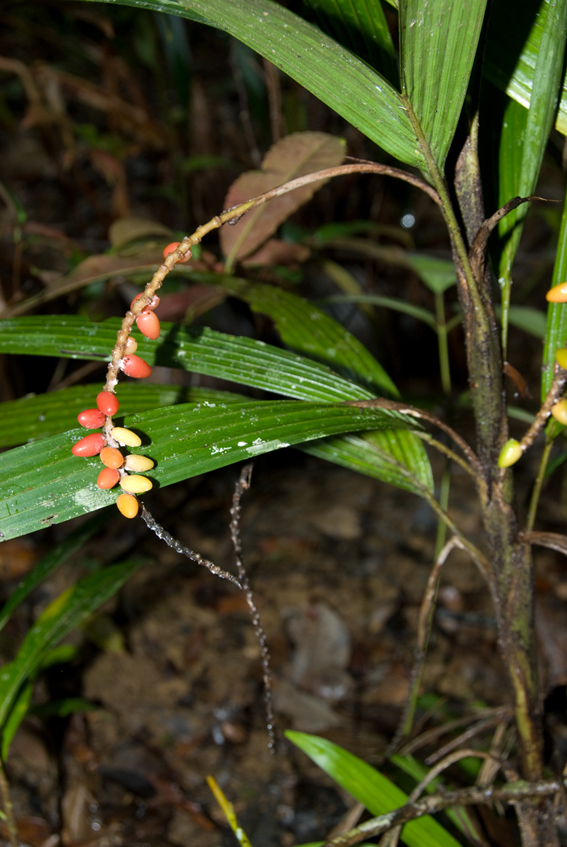- Acanthophoenix
- Acrocomia
- Actinokentia
- Actinorhytis
- Adonidia
- Aiphanes
- Allagoptera
- Ammandra
- Aphandra
- Archontophoenix
- Areca
- Arenga
- Asterogyne
- Astrocaryum
- Attalea
- Bactris
- Balaka
- Barcella
- Basselinia
- Beccariophoenix
- Bismarckia
- Borassodendron
- Borassus
- Brassiophoenix
- Burretiokentia
- Butia
- Calamus
- Calyptrocalyx
- Calyptrogyne
- Calyptronoma
- Carpentaria
- Carpoxylon
- Caryota
- Ceratolobus
- Ceroxylon
- Chamaedorea
- Chamaerops
- Chambeyronia
- Chelyocarpus
- Chuniophoenix
- Clinosperma
- Coccothrinax
- Cocos
- Corypha
- Cryosophila
- Cyphokentia
- Cyphophoenix
- Cyphosperma
- Daemonorops
- Deckenia
- Desmoncus
- Dictyocaryum
- Drymophloeus
- Elaeis
- Eleiodoxa
- Eremospatha
- Eugeissona
- Euterpe
- Gaussia
- Geonoma
- Guihaia
- Hedyscepe
- Hemithrinax
- Howea
- Hyophorbe
- Hyospathe
- Hyphaene
- Iriartea
- Iriartella
- Itaya
- Jailoloa
- Johannesteijsmannia
- Juania
- Jubaea
- Jubaeopsis
- Kentiopsis
- Kerriodoxa
- Korthalsia
- Laccospadix
- Laccosperma
- Lanonia
- Latania
- Lemurophoenix
- Leopoldinia
- Lepidocaryum
- Lepidorrhachis
- Leucothrinax
- Licuala
- Linospadix
- Livistona
- Lodoicea
- Lytocaryum
- Manicaria
- Manjekia
- Marojejya
- Masoala
- Mauritia
- Mauritiella
- Maxburretia
- Medemia
- Metroxylon
- Myrialepis
- Nannorrhops
- Nenga
- Neonicholsonia
- Neoveitchia
- Nephrosperma
- Normanbya
- Nypa
- Oenocarpus
- Oncocalamus
- Oncosperma
- Orania
- Oraniopsis
- Parajubaea
- Pelagodoxa
- Phoenicophorium
- Phoenix
- Pholidocarpus
- Pholidostachys
- Physokentia
- Phytelephas
- Pigafetta
- Pinanga
- Plectocomia
- Plectocomiopsis
- Podococcus
- Pogonotium
- Ponapea
- Prestoea
- Pseudophoenix
- Ptychococcus
- Ptychosperma
- Raphia
- Ravenea
- Reinhardtia
- Retispatha
- Rhapidophyllum
- Rhapis
- Rhopalostylis
- Roscheria
- Roystonea
- Sabal
- Sabinaria
- Salacca
- Saribus
- Satakentia
- Satranala
- Schippia
- Sclerosperma
- Socratea
- Solfia
- Sommieria
- Syagrus
- Synechanthus
- Tahina
- Tectiphiala
- Thrinax
- Trachycarpus
- Trithrinax
- Veitchia
- Verschaffeltia
- Voanioala
- Wallaceodoxa
- Wallichia
- Welfia
- Wendlandiella
- Wettinia
- Wodyetia
- Zombia
- x Jubautia splendens
- ?? Acoelorrhaphe
- ?? Bentinckia
- ?? Brahea
- ?? Clinostigma
- ?? Colpothrinax
- ?? Copernicia
- ?? Cyrtostachys
- ?? Dictyosperma
- ?? Dransfieldia
- ?? Heterospathe
- ?? Hydriastele
- ?? Iguanura
- ?? Incertae sedis & excluded names
- ?? Loxococcus
- ?? Micronoma
- ?? Paripon
- ?? Pritchardia
- ?? Rhopaloblaste
- ?? Serenoa
- ?? Washingtonia

Introduction
- A small solitary undergrowth species from littoral forest, distinct by its entire, deeply lobed leaves and long unbranched inflorescence. The name refers to the collector of the type, Pierre Poivre (1719-1786). (Dransfield, J. & Beentje, H. 1995: The Palms of Madagascar)A
Distribution
Coastal strip around Fenoarivo. (Dransfield, J. & Beentje, H. 1995: The Palms of Madagascar)A
Discussion
- This species slightly resembles D. digitata but is distinct in its shorter petioles and closed leaf sheaths; it is close to D. andapae, but that species clusters and occurs in high mountains. (Dransfield, J. & Beentje, H. 1995: The Palms of Madagascar)A
Biology And Ecology
- Littoral forest (fide Guillaumet). The type of D. poivreana has the description 'palmier aquatique' which seems unlikely. (Dransfield, J. & Beentje, H. 1995: The Palms of Madagascar)A
Conservation
- Critical. Known from only a very small area, in which this kind of vegetation is disappearing rapidly. Not seen in the last twentyfive years. (Dransfield, J. & Beentje, H. 1995: The Palms of Madagascar)A
Common Name
- Hovoka (fide Baron). (Dransfield, J. & Beentje, H. 1995: The Palms of Madagascar)A
Uses
- Not recorded. (Dransfield, J. & Beentje, H. 1995: The Palms of Madagascar)A
Description
- Solitary palm to 80 cm. STEM c. 8 mm diam.; internodes 2.5-4.5 cm, densely pubescent distally. LEAVES c. 8 in the crown, entire; sheath 11-13 cm long, 1/2 to 2/3 closed, with dense scales, auricles 0.7-1 cm; petiole 3-19 cm long, distally 2-3 mm diam., densely scaly or with scattered scales; lamina entire, 24-42 cm long, midrib 5-10 cm long, lobes 19-37 x 2.4-4.5 cm, main veins 5-7, with scattered scales on minor and major veins, apex dentate over a width of 4-12 mm. INFLORESCENCE unbranched; peduncle 14-26 cm long, c. 2 mm diam., densely red-pubescent; prophyll 6-13 cm long, 4.5 mm wide, with reddish flaking pubescence, borne at c. 4 cm above the base of the peduncle, open in the distal 1-1.5 cm; peduncular bract inserted at 6-21 cm from the base of the peduncle, 8-14 cm long, with scattered scales, open in the distal 2 cm, sometimes with a 5 mm beak; non-tubular peduncular bract sometimes present, c. 2 mm; rachilla 11-26 cm, 1.5-2 mm diam., densely scaly, with spaced triads. STAMINATE FLOWERS with sepals 1.3-1.7 x 0.8-1.8 mm; petals on a 0.2-0.4 mm high receptacle, 2-2.6 x 1.3-1.7 mm; stamens 6, biseriate (offset 0.2-0.3 mm), filaments 0.9-1.7 mm and thin (and occasionally connate for c. 0.2 mm), anthers 1.3-1.8 x 0.4-0.6 mm, versatile; pistillode 0.6-1 x 0.3-0.5 mm, pyramidal. PISTILLATE FLOWERS with sepals 1.2-2.2 x 1.6-2.1 mm; petals 3-3.9 x 2.8-3.6 mm; staminodes 0.3-0.9 mm; gynoecium 2.8-4 x 2-2.6 mm, trifid. FRUIT unknown. (Dransfield, J. & Beentje, H. 1995: The Palms of Madagascar)A
Materials Examined
- Fenoarivo Atn.: without precise locality, 1909 (fl.), Geay 9064 (P); Maningory ferry, Jan. 1964 (fl.), Peltier & Peltier 4635 (K, P; some galled flowers present); Tampolo, Feb. 1969 (fl.), Guillaumet 2370 (P). Central Madagascar, without date (fl., y.fr.), Baron 2323 (K). Without any lcality, without date (around 1750?), Poivre s.n. (Holotype P). (Dransfield, J. & Beentje, H. 1995: The Palms of Madagascar)A
- Log in to post comments

